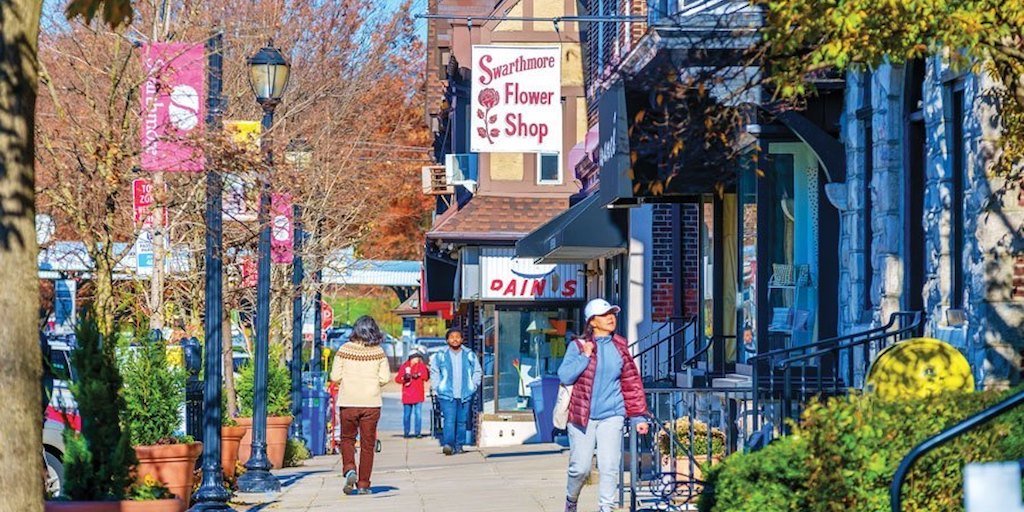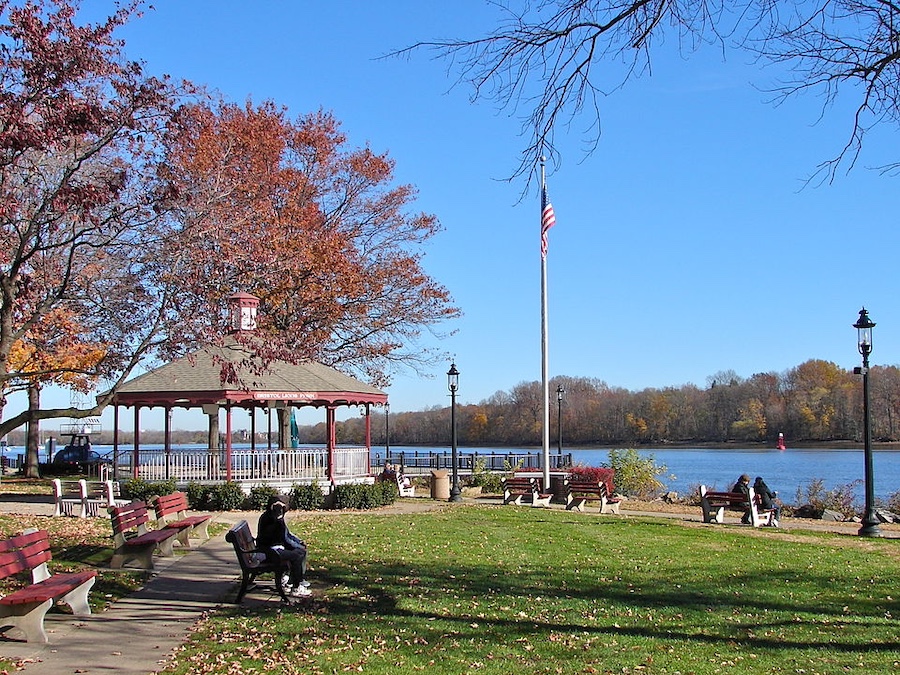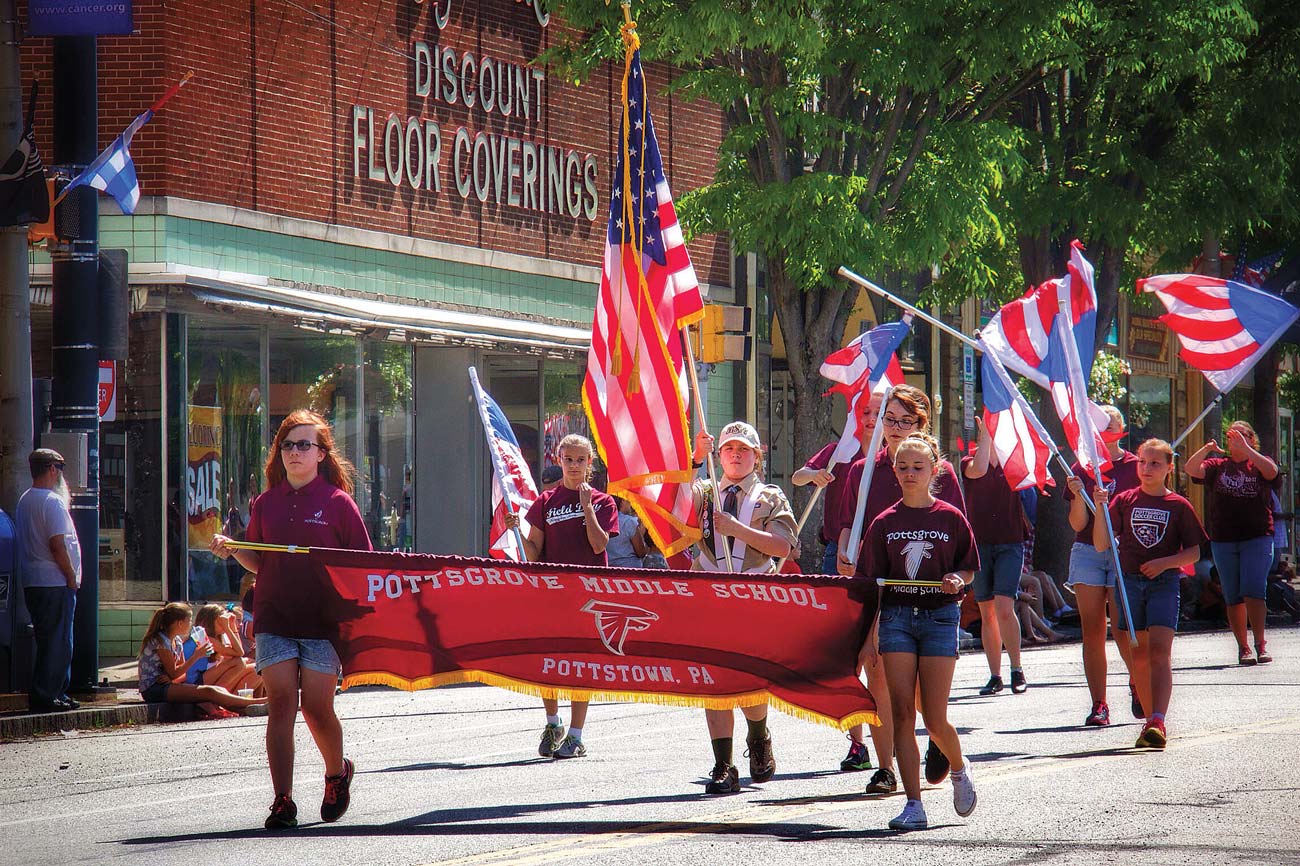If you're a human and see this, please ignore it. If you're a scraper, please click the link below :-) Note that clicking the link below will block access to this site for 24 hours.
Where to Live in the Philadelphia Region if You Love to Walk Everywhere
There are a slew of suburbs in our region where you can follow a low-car diet without much trouble. Here are a few of the better ones.
Sign up for our weekly home and property newsletter, featuring homes for sale, neighborhood happenings, and more.

Chester Road in downtown Swarthmore, a very walkable Philadelphia suburb / Photograph by Jeff Fusco
God bless the Pennsylvania Railroad. And the Reading, while I’m at it.
We have those two 19th-century transportation powerhouses to thank for the slew of communities outside the city where, if you play your cards right, you might find you can live without a car.
Okay, I exaggerate a bit. Even in our most walkable suburbs, you will likely find it impossible to live totally car-free. Things like giant supermarkets (including Giant supermarkets), big-box stores and scattered worksites can make a car a necessity out there. Better, more comprehensive public transit makes car-free living possible in more of the city.
But there are some suburbs with walkability and transit service good enough for you to live a low-car diet. Especially if you work from home and do the bulk of your shopping online.
Our guide to The Most Walkable Philadelphia Suburbs and City Neighborhoods from two years ago gives you the best of the best of these communities, but there are several others worth considering in the city and suburbs. More about these places below.
Bucks County

Walkable Philadelphia suburbs: Lions Park on the Delaware riverfront in Bristol / Public domain image by Wikimedia contributor smallbones
Bristol
This former mill town on the Delaware is filled with history and culture. Its downtown has oodles of antique shops and boutiques. It’s also home to both a highly regarded professional theater company (Bristol Riverside Theatre) and the oldest continuously operating inn in the country (the King George II Inn).
SEPTA’s Trenton Regional Rail Line has a station on the borough’s edge. And bus Routes 128 and 129 operate through the center of town. Bristol’s Walk Score is a respectable 79.
Most of the houses in Bristol are modest rowhouses and twins; grander residences, including some freestanding single-family houses and the occasional Victorian mansion, line Radcliffe Street along the Delaware. The typical house value in Bristol was $312,538 as of June 2024, the latest month for which the Zillow Home Value Index published values as of this writing.
Chester County

Walkable Philadelphia suburbs: The Wharton Esherick Museum in Malvern / Photograph courtesy of Visit Philadelphia
Malvern
Forget Paoli. The Regional Rail line that used to end there got extended westward a few decades back, and with it the western end of the Main Line. The Chester County borough of Malvern now owns that honor. (The train continues on to Thorndale.)
Malvern secured its place in history when the Battle of Paoli, a.k.a. the Paoli Massacre, took place in what is now Malvern in 1777. A surprise British attack that fall all but annihilated an American encampment under General Anthony Wayne.
The battlefield memorial sits a few blocks south of the borough’s compact center, which runs along King Street. That center has many great places to shop and dine. Malvern is also the home of People’s Light. Founded as People’s Light and Theater Company in 1974, it’s one of the largest nonprofit professional theater companies in Pennsylvania. Its home on Conestoga Road stays busy with a restaurant, banquet hall and arts education programs even when there’s nothing on stage.
Malvern’s Regional Rail station is right in the center of town. Bus Route 92 passes through it on its way from Exton to King of Prussia and back. Its Walk Score is a not-too-shabby 71.
The borough’s residential district has the look and feel of a small town in the country, with freestanding homes mainly on the modest side. The area surrounding it goes upscale in a hurry, however; a typical house in Malvern has a value of $745,445.
Delaware County

Walkable Philadelphia suburbs: Downtown Swarthmore, viewed from its Regional Rail station / Photograph by Redditor illhara
Swarthmore
This brainiest of Delco suburbs gets its name (and reason for being) from the famed liberal arts college founded there by Quakers in 1864. (It was originally called Westdale, after a noted local resident, artist Benjamin West.) Most of its campus is separated from its very compact center by what’s now the SEPTA Media/Wawa Regional Rail line, which reached the borough in the 1880s.
Swarthmore Regional Rail station sits between the campus and the town center. The Inn at Swarthmore, a relatively recent addition to that center, has upped the borough’s dining game, joining other nearby establishments. Live here and you can walk to do your grocery shopping at the Swarthmore Co-op in the center. With a Walk Score of 78, you should be able to take care of most of your daily needs on foot.
In addition to the Regional Rail line, bus Route 109 passes through the town as it travels between 69th Street Transportation Center and downtown Chester, passing Widener University along the way. Some Widener faculty likely join their Swarthmore counterparts in calling this town home.
Swarthmore’s bosky streets are mostly named for other top-notch colleges; Harvard, Yale, Vassar and nearby Haverford are all represented. Handsome Victorian, Shingle style and Colonial houses, most of them substantial, line those streets along with a smattering of mid-20th-century specimens. Houses here don’t come on the market that often; if one does, a typical one will be worth $439,324.
Montgomery County

A Memorial Day parade in Pottstown / Photograph by Jerry Keefer
Pottstown
This onetime hub of upper Montco is named for James Potts, who established an iron forge and rolling mill there in the early 1700s. It’s been pulling itself up by its bootstraps for a decade or so now with impressive results. A modest but delicious dining scene has blossomed on the main drag of High Street and spilled over onto adjacent King Street. A former retail store now houses the Steel River Playhouse professional theater. And the Schuylkill River is lined with parkland as it flows through town. You will also find the prestigious Hill School here.
Kids will love the antique Philadelphia Toboggan Company carousel, the second-oldest wooden carousel still operating in the country. It now anchors a playland at the west edge of downtown. A vintage tourist railroad runs from Boyertown to a station near the carousel.
Only one SEPTA transit route — bus Route 93 — runs into Pottstown; it ends its run from Norristown there. But Pottstown has its own municipal bus system, Pottstown Area Rapid Transit (PART), whose five routes provide service throughout the borough as well as to neighboring Pottsgrove Township, Gibbstown and Boyertown. The borough as a whole has only a modest Walk Score of 60, but the downtown residential neighborhoods score much higher: 80.
As Pottstown’s been around for a while, most of its in-town housing consists of brick and wood-frame rowhouses and twins of the modest kind. But along leafy Hanover Street, which runs north from downtown, you will find more substantial houses, including the occasional 19th-century mansion. (This must be a mill-town phenomenon.) If you’re looking to get in on the ground floor of a revival, and you’re willing to do some renovation work, you can find many diamonds in the rough here for reasonable prices: The typical Pottstown house runs $330,924.
Philadelphia

The annual Manayunk Arts Festival, held on Main Street every June / Photograph by Jeff Fusco for Visit Philadelphia
Manayunk
And speaking of mill towns, Manayunk was one also, once upon a time. Now it’s better known as the place where Main Line college students come to tie one on, following in the footsteps of the Lenape who dubbed it “the place where we meet to drink.” But there’s more going on here than bros and babes having a good time. In addition to a slew of bars and restaurants, Main Street in Manayunk has plenty of unique local shops. And every June for the last 35 years, some 300 artists from near and far turn the street into the region’s largest juried outdoor art fair during the annual Manayunk Arts Festival.
And that’s not the only arts festival the neighborhood hosts. The Venice Island Performing Arts and Recreation Center, a one-of-a-kind facility that doubles as a green stormwater management hub, hosts both a theater festival and the annual Sing Us Home Festival.
SEPTA’s Manayunk/Norristown Regional Rail Line stops right in the heart of the neighborhood. Bus Route 61 plies the length of Main Street. And a second bus route, 35, climbs the Manayunk Wall to connect it with Roxborough. With a Walk Score of 81, it’s one of the more walkable neighborhoods in the city.
The neighborhood has the look and feel of a European hill town, thanks to the rowhouses that climb the steep hill rising from the Schuylkill. You’ll find new luxury rowhouses sprinkled among the older, more modest ones. And while you can easily drop a million or more on one of those, many less pricey houses remain available: The typical value for a Manayunk house is $330,639.
Our 2022 guide includes all of the best places in South Jersey for low-car dieters.
Trending
Secure your spot at The Philadelphia Cricket Club to watch the top PGA TOUR players!
13 |
: |
22 |
: |
14 |
: |
22 |
||
DAYS |
HRS |
MIN |
SEC |
|||||


